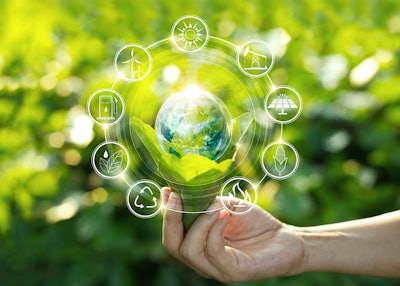
As consumers and businesses become more aware of the impact their purchasing decisions have on the environment, we’re seeing a shift toward sustainability-focused purchasing. To meet sustainability expectations, organizations must invest in new technology while enacting company-wide standards that emphasize a commitment to reducing their carbon footprint.
This is already playing out in a variety of industries. In early 2020, Microsoft announced plans to become carbon negative in the next 10 years and vowed to take environmental impact into account when making supply chain business decisions. A 2016 McKinsey report found that supply chains account for 90% of the environmental damage caused by consumer packaged goods (CPG). As the number of global consumers supply chain support continues to grow, how can CPG companies -- and the entire global supply chain -- reduce its carbon footprint and promote sustainability?
Incorporating sustainable practices into the supply chain
While there has been an increase in the number of electric vehicles on the road, which will help eliminate emissions from last-mile delivery, the technology has yet to have a measurable impact on other modes of transportation. The global supply chain still relies heavily on fossil fuels. Therefore, organizations need to have plans in place that can reduce their reliance on fossil fuels and allow them to reduce emissions where they can until technology catches up.
Implementing artificial intelligence (AI) solutions into supply chain practices is the first step in gaining visibility into organization processes and reducing emissions. With these AI solutions, organizations can collect carbon emission data for specific cargo transportation vehicles while using analytics to prioritize carbon emissions data alongside cost and on-time performance when selecting carriers. By applying enhanced visibility to improve GPS devices and optimize local, domestic and international routes, organizations can receive real-time updates into traffic congestion which will help determine alternate routes that have the least impact on the environment while still meeting delivery dates. Until carriers are able to make the jump to non-fossil fuel-based modes of transportation, route optimization will play a major role in reducing the environmental impact of transportation and distribution.
Using these same AI and advanced analytics solutions, supply chain organizations can make small incremental changes that can help reduce waste and empty miles. Matching export loads with import drop-off locations, enables organizations to significantly reduce empty miles. Additionally, adopting initiatives such as using recycled materials and smaller packaging also contribute to reducing an organization’s overall carbon footprint. As a bonus, smaller packaging allows for additional cargo space.
For freight forwarders, empty space in a container is lost revenue. Through the use of predictive analytics, freight forwarders can better predict the delivery of goods and consolidate shipments from various suppliers with different final destinations. This allows for the most efficient use of assets and resources and it reduces greenhouse gas emissions generated per unit of cargo.
Monitoring and predicting environmental risk
A recent International Energy Agency (IEA) report, found that carbon emissions flatlined in 2019; despite this, the impact of climate change will continue to create new challenges for businesses.
Rising sea levels, wildfires and increased storm frequency (and intensity) all pose a significant threat and impact global supply chain and business operations. Additionally, as the global population continues to grow, the demand for products, resources and raw materials will increase, leading to increased environmental risk. Putting aside greenhouse gas emissions, increased production can result in water and land pollution, toxic waste, deforestation, and issues with air quality and energy use. While these challenges may seem daunting, incremental changes can make a huge difference, if implemented correctly.
These natural disasters pose significant challenges to consumers’ daily lives as well as supply chain efficiency, quality and speed. Advancements in AI and analytics can help predict these risks and facilitate a proactive plan that can reduce downtime and protect employees’ wellbeing. Rather than being reactive when a disaster occurs, supply chain technology can provide key decision-makers with data on the routes, infrastructure and property that is most vulnerable to natural disasters.
Benefits to the global supply chain and community as a whole
Minimizing the environmental impact of the supply chain and industry, in general, will continue to be a focus for companies and consumers as they become more aware of how their goods are sourced, produced and distributed. By becoming environmentally conscious of the supply chain decisions made on a daily basis, organizations will guarantee a more efficient and sustainable supply chain that benefits all stakeholders.
This increased consumer awareness serves as an opportunity for organizations in all industries to lead the charge on sustainability. Thanks to advancements in technology, supply chain managers have more visibility into not just efficiency, but sustainability and ethicality. Technology such as blockchain can verify supplier’s sourcing practices and ensure they’re following governmental or organizational standards. In a time when environmental regulations have been challenging to enact across the globe, supply chain organizations can bridge the gap by enacting and enforcing their own standards. Making a commitment to supply chain sustainability has the potential to strengthen regulatory compliance, improve public perception, reduce waste and overhead, and reassure consumers of a companies’ commitment to the biggest threat of the 21st century.
It’s clear that the global economy is shifting toward a focus on environmental sustainability. Supply chain organizations that capitalize on this shift will be in a position to succeed for the foreseeable future. Achieving this success requires a forward-thinking supply chain, that takes into account consumer trends, combined with the right technology solutions that help organizations build a more sustainable, responsible and ethical supply chain for employees, consumers and organizations as a whole.




















